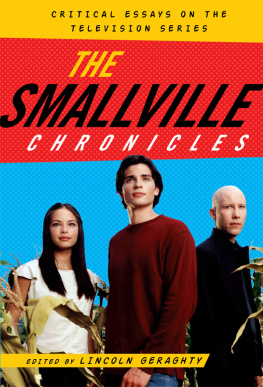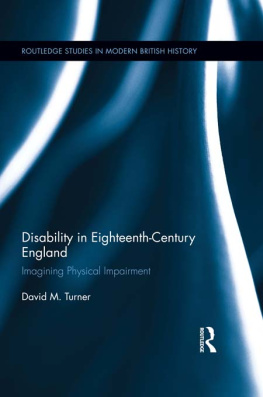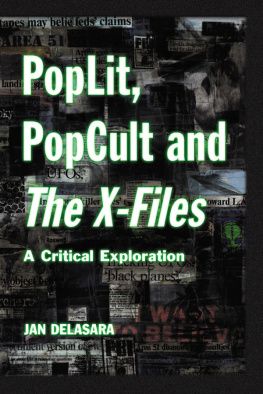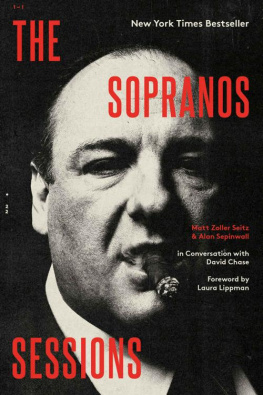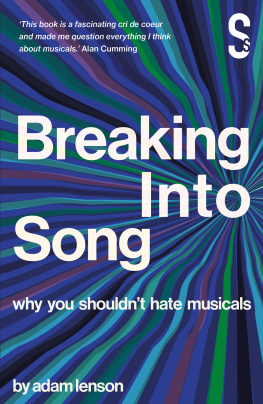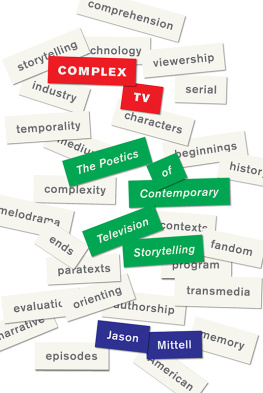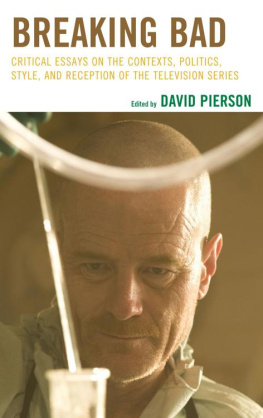BREAKING BAD
Critical Essays on the Contexts, Politics, Style, and Reception of the Television Series
Edited by David P. Pierson
Because researching and writing an edited collection of scholarly essays is always a collaborative effort, I would like to take this opportunity to thank a number of people who provided assistance, advice, and encouragement in the publication of this book. Special thanks goes to Lindsey Porambo at Lexington Books for her steady support, assistance, and guidance through the manuscript revision and publication process. Lindsey was always patient, friendly, and responsive in addressing my numerous inquiries. I would also like to thank the manuscript reviewers who provided invaluable input on revisions and all the editorial and marketing staff at Lexington Books for their due diligence and professionalism. My gratitude further goes out to my unwavering chapter contributors whose work lies at the heart of this collection. It probably goes without saying (but I will still say it) that the true measure of a scholarly edited collection resides with the quality of work of its contributors. The books persuasive diversity of perspectives and creative scholarship to Breaking Bad as a complex television series clearly speaks for itself.
Closer to home, I would like to thank my colleagues in the Department of Communication and Media Studies at the University of Southern Maine for their support of my research and scholarship efforts. Finally, I would like to thank my wife, Carol, who provided extraordinary support and encouragement throughout the books original conception to its final stage. She served as my first editor reading through copious abstract submissions, then providing editorial comments and advice on the submitted chapter manuscripts. This book collection would not be possible without her steadfast love and support.
David P. PiersonUniversity of Southern Maine, June 2013
A pair of pants floats freely in the air gently landing on a desolate desert road only to be run over by a speeding Winnebago. The RVs driver is a middle-aged man wearing a ventilator mask and dressed in only white underwear briefs. In the passenger seat another man either passed out or dead also wears a ventilator mask. Two bodies slide across the floor of the RV until it come it comes to an abrupt stop in a ditch. The driver jumps out gagging from the fumes, puts on a dress shirt, then re-enters to retrieve a video camera, his wallet, and a gun. He records a brief, farewell message to his family, then stands defiantly facing a barrage of oncoming sirens with a large gun in his hand. Breaking Bads pilot episode begins with this disorientating, surreal sequence. We discover through a narrative flashback three weeks earlier how the man (Walter White) came to be in this strange, perilous situation.
Walter, played by Bryan Cranston, is a fifty-year-old, financially-strapped high school chemistry teacher living in Albuquerque, New Mexico who moonlights as a cashier at a car wash to support his pregnant wife, Skyler (Anna Gunn), and his disabled, teenage son, Walter Junior (R.J. Mitte). After he collapses at the car wash and is taken to the hospital by ambulance, the doctor verifies the worst. The non-smoking Walt has inoperable lung cancer and with chemotherapy treatments, he has only a couple of years to live. When Walt tags along on a drug bust led by brother-in-law DEA agent Hank Schrader (Dean Norris), he not only learns about the highly-profitable nature of the illegal methamphetamine (meth) market, but spots an ex-student Jesse Pinkman (Aaron Paul) escaping the crime scene. Later that same day, he approaches Jesse offering to either become his partner or to he will turn him in. Working in a used Winnebago converted to a mobile lab, Walt cooks a batch of crystal meth that Jesse declares is the purest crystal he has ever seen. In search of a distributor, Jesse takes a sample of the crystal to Krazy-8, a local drug dealer who happens to be his former partners cousin. Cousin Emilio, out on bail, believes that Jesse informed on him during the drug bust and the three drive out to the desert to meet Walt. Emilio recognizes Walt from the drug bust and Krazy-8 threatens to kill Walt and Jesse. Walt barters for his life by promising to show them his chemical artistry. Instead, Walt produces a deadly smoke, then dashes out of the RV. Walt places a ventilator mask on an unconscious Jesse and then places him in the passengers seat. The subsequent scenes repeat the same actions shown at the beginning of the episode. While Breaking Bads story premise of a middle-aged, chemistry teacher turned drug dealer may sound implausible or even morally objectionable, the series has proven to be a huge commercial success for the AMC Network. Breaking Bad garners an audience less than the two-million-plus viewers who watch its critically-acclaimed, original series Mad Men. Cranston, who formerly played the goofy father on Malcolm in the Middle (2000-2006), has been praised by critics for his intense, volatile performance as Walter White. Breaking Bad has received its share of critical accolades including winning six Emmy Awards and three consecutive wins for Outstanding Actor in a Lead Drama Series for Cranston and a Best Supporting Actor award for Aaron Paul (Kroll 2010).
Despite its commercial and critical success, the series has not been exempt from public criticism. Jill Sergeant (2009) says that Walt Whites decision to use his chemistry skills to cook up and sell crystal methamphetamineone of the most highly addictive drugshas stirred controversy. Some people have expressed concern that the series may be having a bad influence on certain young viewers. Of course Breaking Bad hardly glamorizes the illegal world of meth dealing because so many of its participants are victims of brutal, untimely deaths, including being crushed, decapitated, poisoned, shot, stabbed, and strangled. However, in this same vein, the series has also been criticized for pushing cable boundaries with its profanity and violent content, as well as its decision to portray its violent acts as black comedy. Beyond its controversial content, Breaking Bad touches on several salient topics, including the social vulnerability of middle and working-class Americans in a neoliberal economy and society; fatalism and the moral universe of Breaking Bad; the social morality of the war on drugs; race, Latino Americans, and border politics; the global economy and crises of masculinity; and life and myth in the modern American Southwest. Despite its popularity and its association with a diverse range of relevant topics, there have been sparse scholarly studies of Breaking Bad. One such study is David Koepsell and Robert Arps Breaking Bad and Philosophy (2012), an edited collection of essays on how Walt and his crimes relate to major philosophical themes and the central philosophical dilemmas that comprise everyday life. The book highlights such philosophical questions as can a person be transformed as the result of a few key life choices, does everyone have the capacity to become ruthless criminal, how would you respond to the news that you only have six months to live, and does the Heisenberg Principle of Uncertainty rule our life destinies? Although Koepsell and Arps book explores Breaking Bad series from several philosophical stances, it does not examine the series, its visual and aural style, its narratives, and its main characters and their representations from a broad range of critical perspectivescritical-cultural, gender studies, narratological, political-economic, sociologicalall in an endeavor to delve deeply into the complex world of Breaking Bad.




